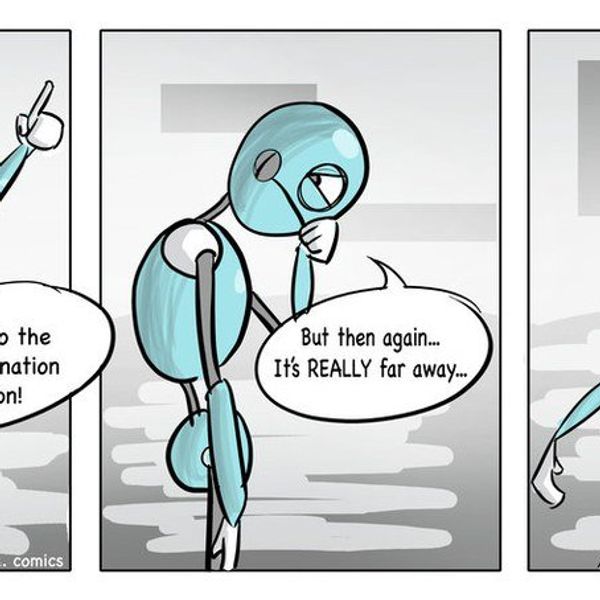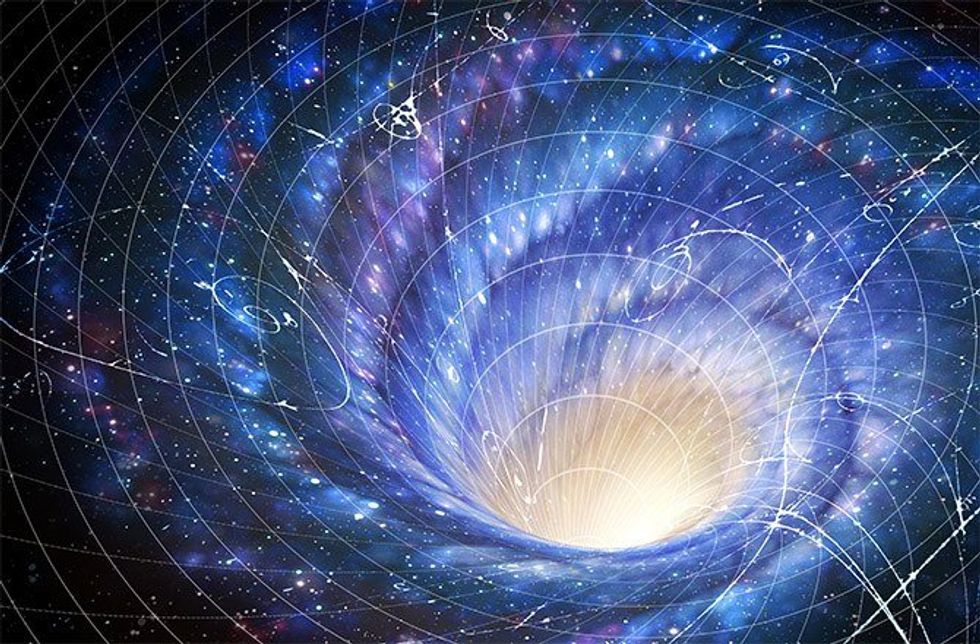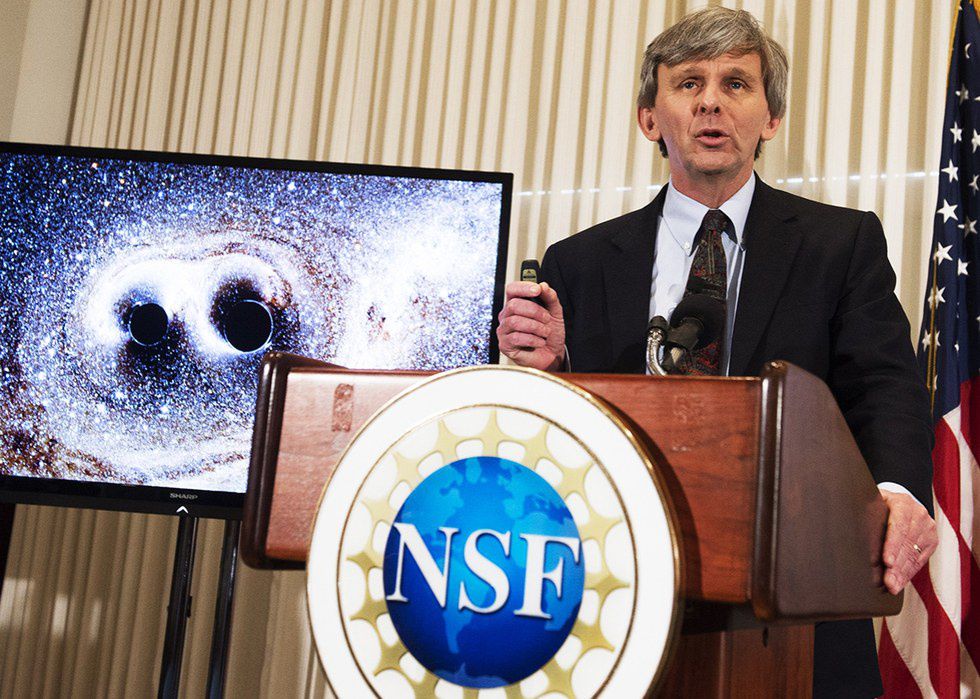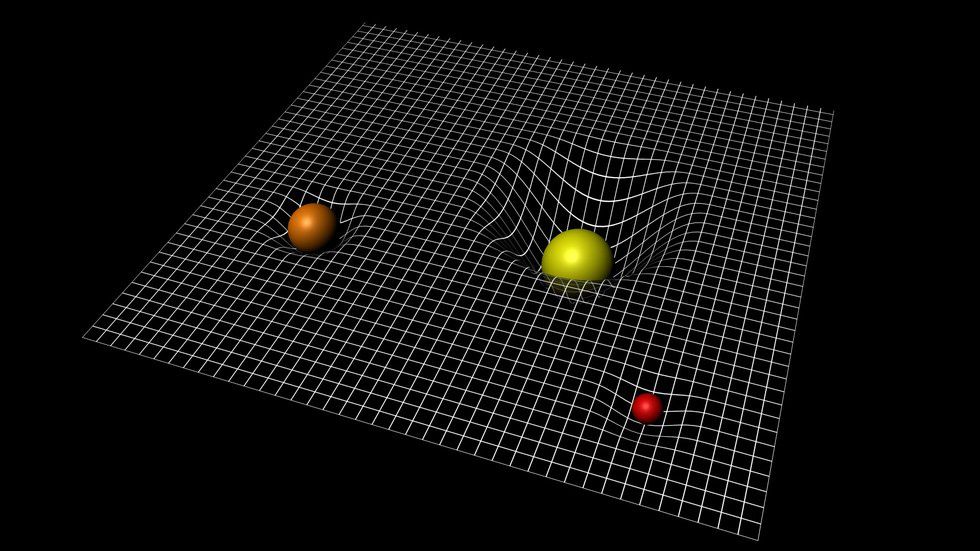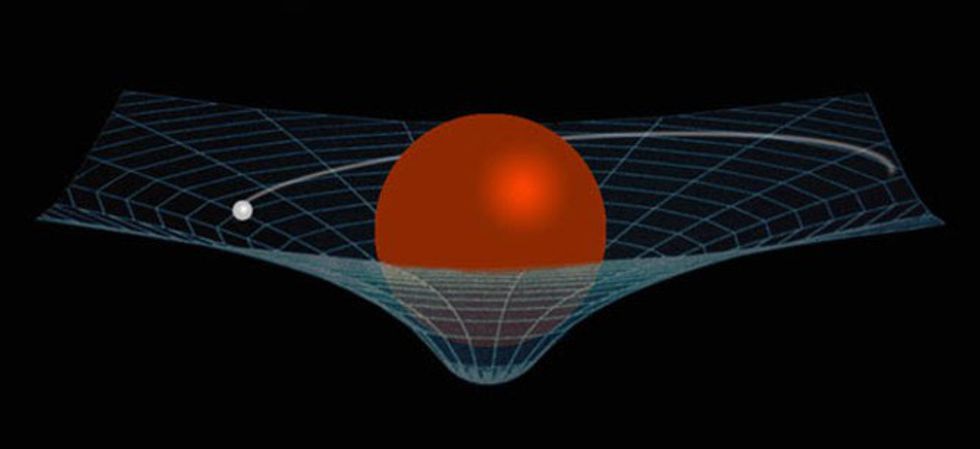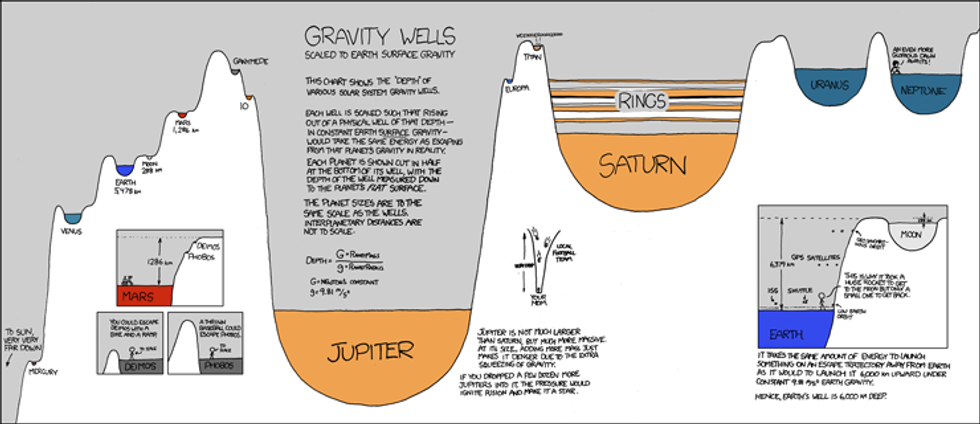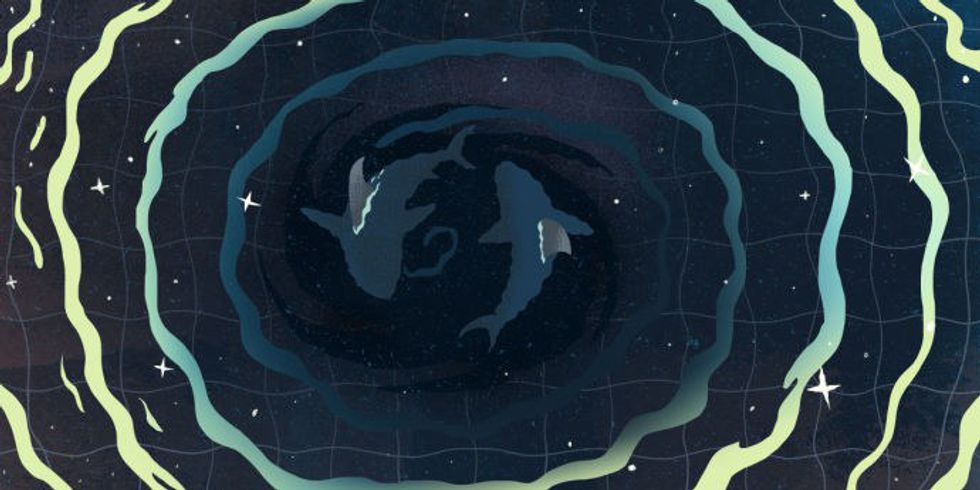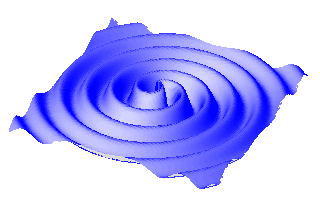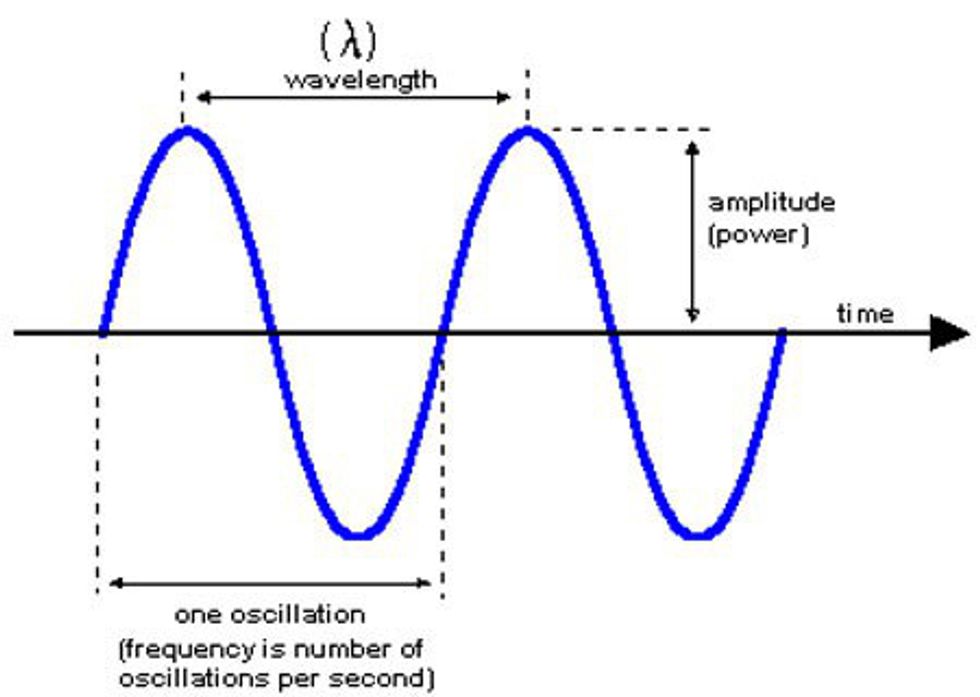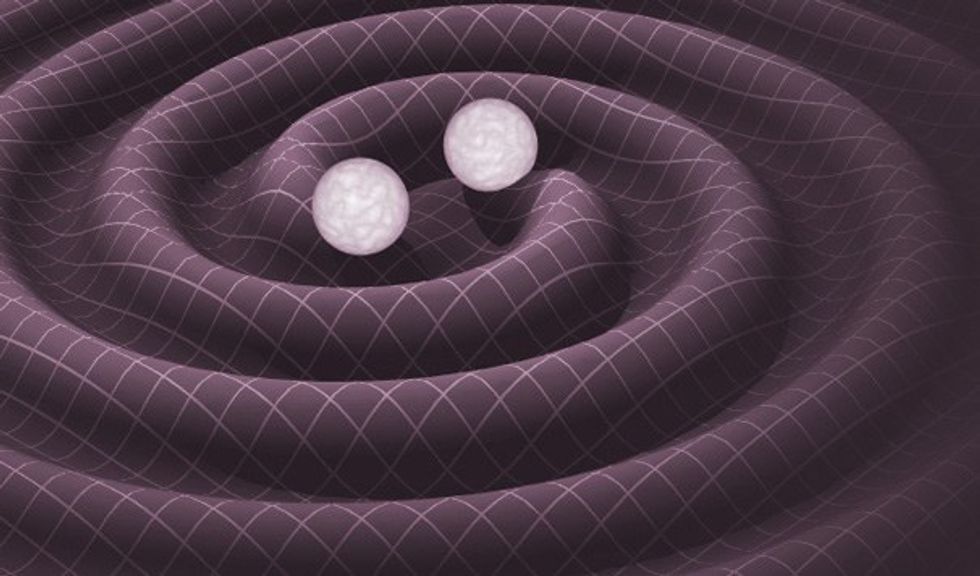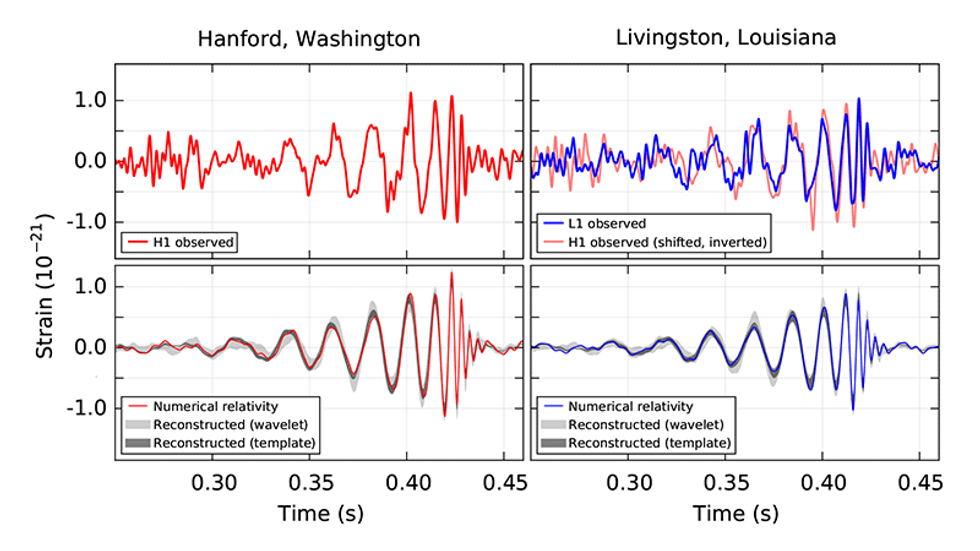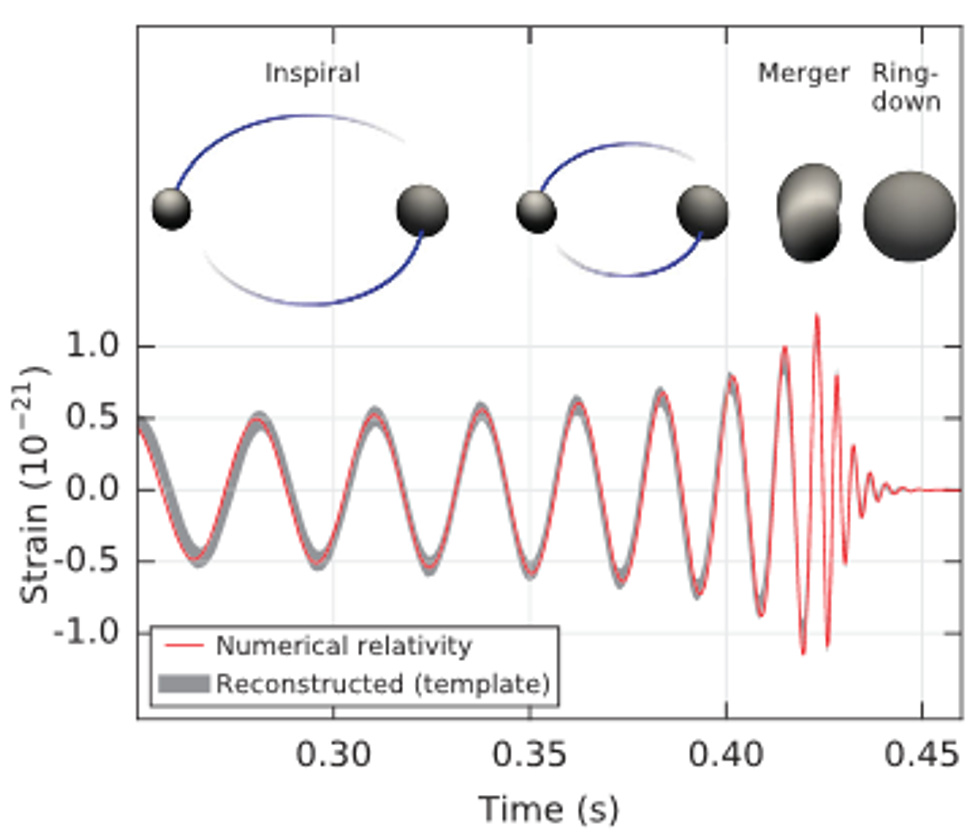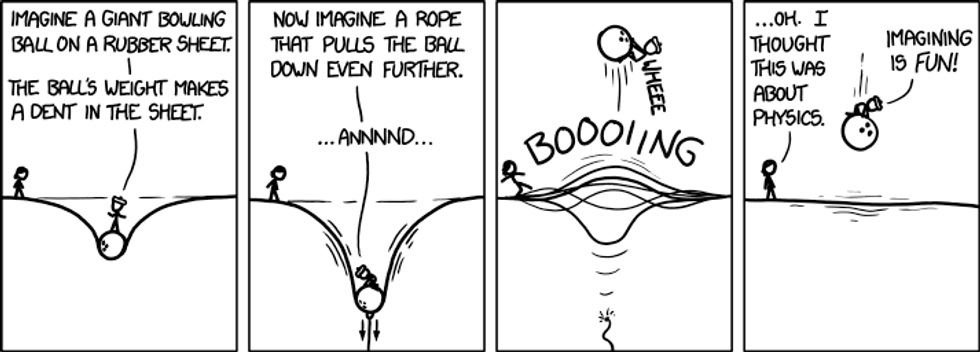It’s an incredibly exciting time to be an Astrophysics student. As a senior, I’ve had the unique opportunity to witness two game-changing physics discoveries while attending Whitman: the detection of the Higgs Boson (i.e. the “God Particle”), and now detection of gravitational waves from two black holes colliding. Physicists say that these gravitationally insane black holes are the discovery of the decade, yet most of the general public doesn’t understand why this discovery is so cool, or what the detection even was. I’ll do my best to clearly explain gravitational wave detection, and concepts behind it.
On Feb. 11, 2016, a panel of five Laser Interferometer Gravitational-Wave Observatory (LIGO) scientists announced to the world that they had detected gravitational waves emitted from an inspiraling binary black hole system. The two black holes were 29 and 36 times the mass of the sun, and after combining they ejected three solar masses worth of energy. In the image below, David Reitze announces, "We have detected gravitational waves," at the press conference in Washington, D.C. The image next to him is an artist's impression of the two black holes.
OK, yes. This information has been circling the internet for a while now. But let's dissect what gravitational waves, black holes and space-time are. We need to go back to the beginning, starting with Einstein.
Background on Space-Time:
In 1915, Albert Einstein published his "Field Equations of Gravitation" paper and opened our eyes to the world of General Relativity. (This is where his famous e = mc^2 equation was published!) But the part of his theory that we need right now is his imagination of the fabric of space-time. In his paper, Einstein argued that in the large scale view of the universe, space and time are not static and unchanging, quite the opposite in fact. The fabric of space-time is constantly stretched in different directions. As the name suggests, space-time has two major components: space and time. (Could have guessed!) When space-time gets stretched and squished, spatial distances get distorted, and time gets distorted as well. But, enough of that. Back to space-time fabric.
An easy way to picture this “fabric” of space-time is to think of a think latex sheet stretched over the top of a basket. When you put things on the latex sheet, the fabric will depress downward, creating a little well. If you put a piece of popcorn on the sheet, it would make a tiny unperceivable well, but if you put a bowling ball on it, there will be a huge deep well. More massive objects create deeper wells. In this photo, there are three objects with different masses. The yellow object creates the largest indent, indicating that it has the most mass, while the red object is the least massive and the brown one is in between.
Now using this sheet model, we can extend this metaphor out to the rest of the universe. Instead of the sheet being the size of a basket, it would be the size of the universe! And instead of dropping popcorn and bowling balls on the sheet, drop stars and planets and black holes! Again, more massive objects (like stars) create deeper wells than objects with smaller mass (like planets). Astrophysicists call these deep indents “gravitational wells."
This name actually makes sense. Think of a bouncy ball rolling on our latex sheet towards the bowling ball’s well. The bouncy ball will start out moving in a straight line, but then get caught up in the curvature of the sheet, and roll towards the bowling ball. In this way, it is a pretty accurate representation of the bouncy ball getting caught in the gravitational field of the bowling ball.
Since, more massive objects create larger gravity wells, this also means that they have more extended gravity fields. Having a stronger gravitational field means you can affect things that are much farther away. In the photo above, we can imagine that the little white moon is caught in the red planet's gravitational field.
Here's a cool graphic depicting the relative sizes of planetary gravitational wells in our solar system!
Now, we've talked about gravitational wells, but what exactly is a gravitational wave? Up until now, we have been imagining the universe as an enormous sheet of fabric with planets, stars, nebulae, etc. sprinkled on top of it, creating little pockets and indents. This is still a good model, but keep in mind that everything is moving. Take our solar system, for example. With the sun in the middle and planets orbiting around it, everything is moving (even the sun a little bit!). As these astronomical bodies move, they create small waves in their wake. Think of these waves like a boat gliding through water, it creates ripples along the surface. Generally, these ripples are too small to affect anything, but when the astronomical bodies in question are hugely massive black holes, these gravitational waves become a major player.
Gravitational Waves and LIGO:
Located just 67.8 miles from Whitman’s campus is half of the world’s leading gravitational wave detection sites. There is a detector in Hanford, Washington, and another in Livingston, Louisiana. Both detectors are part of the project called “LIGO”. LIGO stands for Laser Interferometer Gravitational wave Observatory. Its largest strength is that their detectors can pick up these unbelievably tiny fluctuations in space-time. The photos below show the Hanford and Livingston observatories.
I watched LIGO’s press conference announcement on Feb. 11, 2016, and they showed an animation of planet Earth getting squished and squashed up and down and right and left. This disturbing end-of-days animation showed an exaggerated representation of what gravitational waves do to space objects. Since we all live inside the fabric of space-time, those ripples will 100 percent affect us. Yes, it is true that they distort the shape of objects back and forth, but the amount of distortion is so miniscule that it would not even appear in an animation. It is so miniscule that (until now!) we haven't been able to notice it happening.
On Sept. 14, 2015, the detector chirped, indicating that gravity waves were passing through the detector and causing the length of things to become slightly distorted. The strength and frequency of the signal showed gravity waves created by two massive black holes orbiting each other. With masses of 29 and 36 solar masses, these black holes created serious gravitational waves in space-time.
To picture gravitational waves from the black holes, imagine two sharks swimming just under the ocean surface. They are circling each other in a really tight loop with their dorsal fins cutting through the water. Imagine the waves they create on the surface as they swim around each other. The waves will look like swirls coming out of the center. Now imagine that the water is the surface of space-time, and the sharks are 29 and 36 solar masses. If that doesn't scare you, I don't know what will... Maybe I should have chosen dolphins or something. But this is still a useful analogy.
If the sharks start swimming faster, how will the waves look different? The wave peaks will get closer together with higher peaks because the sharks are expending more energy out to the system. To physicists, this means their frequency (how many peaks per second) and their amplitude (peak height) both increase. Sharks that swim faster circles create larger, faster waves. Coincidentally, black holes that are circling faster exhibit larger, faster gravitational waves. Using the language of "larger" meaning higher amplitude, "faster" meaning increased frequency. The picture below is a visual representation of frequency and amplitude of an example wave.
To recap what we just learned about objects spiraling around each other... Two spiraling objects create waves that spiral outwards. If the objects increase their speed, the waves will exhibit higher (taller) amplitudes and higher (faster) frequencies.
In the case of the binary black hole system, the black holes were orbiting each other in a degrading orbit. This means that they were falling inwards toward each other with each revolution. As they got closer together, the black holes sped up until they were going over 0.5 times the speed of light. Imagine dragging something that is 36 times the mass of the sun at half the speed of light. Crazy.
LIGO's Signal:
LIGO detected a signal from these black holes as they were spiraling around each other, and that signal was exactly as we would expect according to Einstein's principles! Pretty cool when science works out so beautifully. The signal showed a wave that increased its amplitude and frequency over time! This is just as general relativity postulated, and what we predicted with our sharks! Here is what the signal looked like:
The bottom graphs on this chart represent the waveform predicted by the relativity equations, and the top graphs show the actual results from Hanford, Washington (left) and Livingston, Louisiana (right). They are almost eerily similar. As you can see, the waves get closer together (increase in frequency) and the peaks get taller (increase in amplitude) as the two black holes orbit each other faster and faster while falling in towards each other.
It is worth mentioning that this distortion in space-time was only one part in 10^21. That means that the length of the entire detector changed by (1/10^21)th. Which is a change of 0.000000000000000000001. So, 20 zeros in front of that one. LIGO scientists like to come up with analogies to help us visualize just how tiny this number is, and the one I've heard most often is: "This is the width of an atom!" Pretty small! Here's another way to think about it: if your detector took up the entire distance from planet Earth to Saturn, 1/10^21 of that length would be the width of a human hair. Tiny tiny tiny.
Yet, the signal only lasted less than 0.2 seconds. What made it stop?
The black holes got so close to each other that they morphed into one entity and became one monstrous black hole of 62 solar masses. This graphic shows how the gravitational wave signal corresponds to the black holes' orientation:
As shown, the "merger" caused most of the gravitational wave havoc, due to its asymmetry, but it was quickly resolved in the "ringdown" in which the black hole corrected itself into a perfect spherical shape.
If you're really astute, you may have noticed that the resulting gargantuan black hole was 62 solar masses, when the two black holes combined to create it were 29 and 36. 29 + 36 definitely does not equal 62, so what happened to the extra three solar masses? Here is a real-life application of e = mc^2. Those extra 3 solar masses got completely converted into energy during the collision. In Einstein's equation, e = energy, m = mass, c = speed of light. This equation defines the term "mass energy" and is perfect for describing what happens when mass is converted directly into energy.
The Craziest Thing:
Most of the things you have just read can qualify as pretty crazy... But this fact really floored me when I learned about it. These gravitational waves are pulsating at frequencies that the human ear can detect.
We can hear these black holes colliding.
Space is silent, as a rule. But for the first time ever, scientists heard the universe. And before you get all excited about huge, eardrum-shattering explosions, it is not like that at all. Recall that these gravitational waves are tiny tiny tiny. If you whisper the word "boink" to yourself, that's pretty much what it sounds like. The pitch goes up slightly as the frequency increases, and it is over in 0.2 seconds. Huzzah! The sounds of space!
Here's a clip of the "gravitational wave chirp." It is hard to hear, but it is definitely there!
I'm looking forward to writing more articles as part of the "become a Part-time Astrophysicist" series. A few more articles in the works are: Relativity, Generally; Interferometers and LIGO; The Duality of Light; Crash course in Wave Mechanics.
But before I leave, here's what astrophysicists do on their days off...
Sources and Resources:
If you're really into this and want to learn more, check out the bolded websites!
4. Wikipedia "List of Scientific Publications by Albert Einstein"
6. XKCD.com
7. U. Arizona
9. Explain XKCD
10. Slate "Health and Science"
12. News Discovery "Gravitational Waves Detected"
13. Blog "Electromagnetic Radiation"

